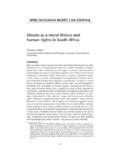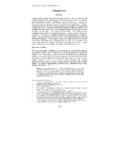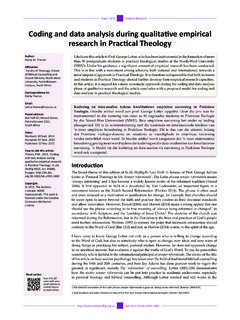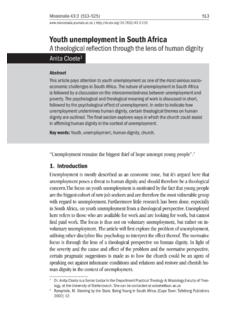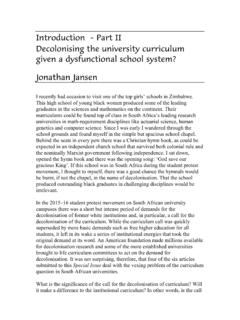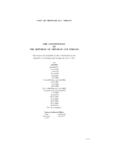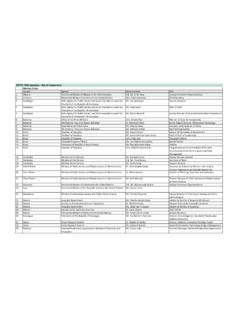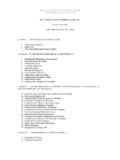Transcription of Chloë McGrath and Elrena van der Spuy* - SciELO
1 39SA Crime QuArterly No. 48 juNe 2014 Looking back Insider views on the Judicial Inspectorate for Correctional Services chlo McGrath and Elrena van der brief: South African prisons Under apartheid, South African prisons bore the imprint of racialised and repressive rule. The opportunity for a fundamental re-think of the policy framework had to await the establishment of a constitutional democracy. Bold efforts at redesigning the system of incarceration were put forward, but uneven implementation has diluted many of the visions set out on paper.
2 Twenty years into the new dispensation, South African prisons continue to confront a mix of structural fault lines, bureaucratic intransigence, resource constraints and a measure of political indifference to the plight of In 2001 the Parliamentary Portfolio Committee for Correctional Services called for an independent inquiry in the Department of Correctional Services (DCS) on issues of corruption. In 2006, after five years of collecting evidence, the Commission of Inquiry into Alleged Incidents of Violence or Intimidation in the Department of Correctional Services (the Jali Commission) declared that the department was arguably no longer governable.
3 3 The report highlighted a wide range of ailments: widespread patterns of corruption in the procurement of goods and services and in appointments, administrative ineptitude, a routinisation of abuse of inmates, widespread sexual violence among inmates, gangsterism,4 endemic overcrowding,5 and departmental capture by the Police and Prisons Civil Rights Union (POPCRU). At present the DCS has the capacity to house 118 441 inmates across 242 correctional The inmate population has long exceeded capacity. The current inmate population of 150 608 shows an overcrowding rate of 127%.
4 7 Overcrowding has significantly contributed to poor prison conditions and human rights standards are frequently infringed as a result of the burgeoning numbers of In 2013, pre-trial persons constituted 32% of the total incarcerated * Elrena van der Spuy is attached to the Centre of Criminology, Faculty of Law at the University of Cape Town. chlo McGrath was a researcher attached to the Centre of Criminology in 2013 and has been awarded a Fulbright scholarship for post-graduate studies from August 2014 establishment of a constitutional democracy in South Africa necessitated widespread institutional reforms across state sectors.
5 A key feature of such reforms was the emphasis on oversight and accountability as illustrated in reform endeavours pursued in the South African Police Service, courts and prisons. One such oversight mechanism the Judicial Inspectorate for Correctional Services (JICS) is the subject of this article. Drawing on qualitative interviews with people closely involved with the JICS since 1998, this article presents insider views regarding the JICS. We conclude with incumbents views on the effectiveness of the foR SecURiTy STUdieS40In brief: the Judicial Inspectorate for Correctional Services The Judicial Inspectorate for Correctional Services (JICS) was established in 1998 and became a fully functioning office in 2000.
6 The office is headed up by an Inspecting Judge (IJ), who is assisted by a Chief Executive Officer (CEO), under whom are three units: the support services directorate, the legal services directorate, and the management regions directorate. The CEO must appoint an Independent Correctional Centre Visitor (ICCV) for each correctional facility. The role of the ICCV is to regularly visit correctional centres, interview inmates and record complaints, and attempt to resolve complaints with the DCS where possible, submitting unresolved complaints to the IJ and writing monthly reports to be submitted to the IJ s Visitors Committees (VC) are then established to deal with unresolved complaints, schedule visits to correctional facilities, and engage with community leaders.
7 The total expenditure of the JICS for the 2012/3 year was R31 321 In the 2012/13 year, the ICCVs dealt with 530 183 complaints across 242 correctional Four key pieces of research12 have evaluated both the necessity for and the efficacy of the JICS. While in agreement that an independent watchdog to provide oversight in South Africa s correctional centres is absolutely necessary, the research has raised serious concerns about its functional independence and its lack of power to enforce recommendations. While the JICS publishes the number of complaints, it does not indicate whether these complaints are resolved.
8 Furthermore, although the JICS has been highly critical of the DCS, its recommendations and findings have been largely disregarded by the DCS. How do those situated at the upper echelons of the JICS reflect on the mandate, role, achievements and challenges of this oversight mechanism?Research methodsThis study combined elements of oral history methodology with in-depth interviews. The group of 15 respondents included two drafters of the legislation13 in terms of which the JICS was established; six Inspecting Judges,14 a former Inspector,15 a former Director and a current CEO,16 the Head of the Parliamentary Portfolio Committee for the Department of Correctional Services,17 and three research The choice of participants proceeded via purposive sampling so as to include all six Inspecting Judges who served terms between 1999 and 2013, and five others who fulfilled key roles in the design and operation of the JICS.
9 Three researchers of prisons provided informed comment on prison reform. The face-to-face interviews of approximately two hours duration each were audio recorded and transcribed during the second half of 2013. All interviewees consented to having their interviews archived in an open access the analysis of the interview material we made use of a thematic checklist based on the themes explored in the interviews. The themes included: individual pathways to the Judicial Inspectorate;19 key features of South African prisons past and present; core components of the JICS; key moments in the evolution of the JICS; challenges relating to the management of relations and establishing networks; and views on the contribution of the JICS to the democratic administration of Key features of prisons past and presentWe asked JICS incumbents to reflect on key features of prisons inherited from the past at the point that reconstruction got underway.
10 The responses served as a reminder of a deeply racialised system, managed along para-military lines, beset by overcrowding and overseen by extremely limited forms of oversight. Prior to the 1990s, racial segregation in prisons was prescribed in legislation and enforced throughout the One of our interviewees, a former political detainee, described it as follows:Prior to 1994 of course the first thing was that there was apartheid in prisons. It was very strictly applied. Even the police was more kind of integrated. In the prison apparatus itself, they were very strict.
